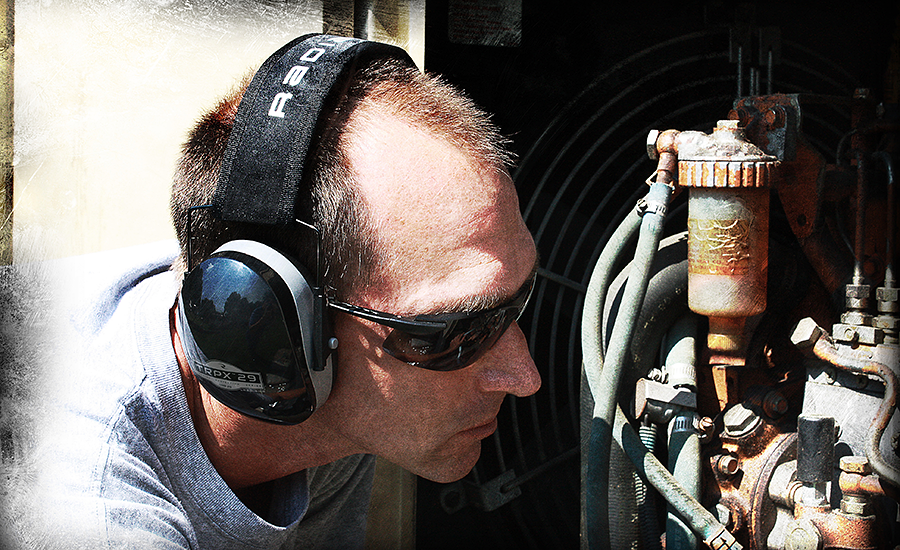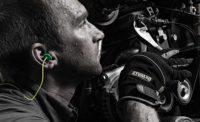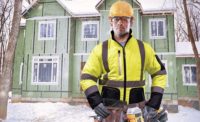During COVID-19, many people have missed listening to live music and hearing the pulsating sounds of drums, electric guitars, and professional singers.
Others have missed attending live sporting events and hearing the cheers and hoopla from fans like themselves who share the bond of a favorite team.
And some people long for late-night laughter and colorful conversations while enjoying craft beers and burgers at their favorite bar or restaurant.
During this pandemic year, think how difficult and sad it has been not hearing the sounds we love. Now, imagine if your hearing were gone forever or seriously impaired. It’s not a good situation, but it’s a real one, especially in the industrial workplace.
Hearing loss is a pervasive problem
According to the National Institute of Occupational Safety and Health (NIOSH): “Hearing loss is one of the most pervasive problems in today's occupational environment, affecting workers in manufacturing, construction, transportation, agriculture, and the military. Approximately 32 million workers overall are exposed to noise levels or toxicants that are potentially hazardous to their hearing.”
About 16 million workers of the 32 million work in manufacturing, so as America brings manufacturing back to the USA, preventing hearing loss could become more prevalent than ever.
How serious is it?
Often referred to as the “invisible disability,” the Centers for Disease Control (CDC) shares these somber statistics about hearing loss and impairment:
- In the United States, hearing loss is the third-most common chronic physical condition among adults after hypertension and arthritis.
- About 12% of the U.S. working population has hearing difficulty.
- About 24% of the hearing difficulty among U.S. workers is caused by occupational exposures.
- About 8% of the U.S. working population has tinnitus (ringing in the ears), and 4% of workers have both hearing difficulty and tinnitus.
Fortunately, noise-induced hearing loss can be reduced, or often eliminated, through the execution of a successful hearing conservation program (HCP) that benefits both the employer and the employee.
What makes a successful Hearing Conservation Program (HCP)?
The factors are many, including:
- noise measurement
- audiometric testing
- hearing protection through engineering, administrative, and PPE controls
- motivational education and training
- recordkeeping
- personal preference considerations
For in-depth HCP information, you can refer to a comprehensive public domain document called NIOSH Publication No. 96-110, Preventing Occupational Hearing Loss, a Practical Guide1. This guide has information that will help with program development and training modules. Because this document is in the public domain, you can use the information without seeking permission to reprint or use. Many PPE manufacturers also have resources and tools to help you develop a hearing conservation program.
However, no matter the scope of a hearing conservation program, the 5 Cs of HCPs will play an important role in worker adoption. The 5 Cs are:
- Compliance
- Comfort
- Convenience
- Communication
- Commitment
Compliance
OSHA compliance requires employers to develop and implement a hearing conservation program when the worker's noise exposure equals or exceeds an 8-hour time-weighted average of 85 decibels on the A scale (dBA). [29 CFR 1910.95(c)]
Hearing loss from noise pollution often happens from repeated exposure to prolonged noises. It can also occur from sudden exposure to a dangerously loud noise like a shot gun blast or machines that suddenly make loud noises during operation. One type of hearing loss is gradual; the other sudden and often not prepared for.
Since the leading cause of hearing loss is exposure to loud sounds 85 decibels or higher, let’s look at common noise sounds and their decibel rating.
- Normal conversation—50 to 85 dB
- Lawnmower and city traffic—85 dB
- Farm tractor—98 dB
- Jackhammer and chainsaw—110 dB
- iPod at peak volumes—115 dB
- Rock concert or symphony can range-- 110 dB to 140 dB
- Gun shot and fireworks—140 dB
NIOSH says that workers shall be required to wear hearing protectors when engaged in work that exposes them to noise that equals or exceeds 85 dBA as an 8-hour TWA. Additionally, the employer shall provide hearing protectors at no cost to the workers.
OSHA compliance requires that safety pros identify all potential sources of noise pollution, determine whether noise levels are potentially dangerous, and then implement safety standards to protect their employees, including Personal Protective Equipment (PPE).
PPE is especially important when engineering and administrative controls can’t or don’t solve workplace noise pollution.
Numerous types of hearing protectors are available to satisfy different work environments. No matter the type of device, if the HPD isn’t comfortable to wear for long hours at a time, workers may resist wearing it; and compliance is more difficult to achieve.
Comfort
“While workers are becoming ever-increasingly aware of the need to protect against hearing loss, they are unlikely to wear hearing protection devices (HPDs) that are heavy, large, ill-fitting and uncomfortable,” said Sr. Product Specialist Cindy Bullion-LaWarre, who oversees new product development for hearing and vision protection at a top-tier PPE manufacturer. To satisfy the need for more comfort, Bullion-LaWarre says that safety pros can specify:
- Earmuffs with padded, moisture-wicking headbands that can be adjusted for a comfortable, secure fit.
- Low profile ear cups that increase side visibility, fold for easy storage, and provide a Noise Reduction Rating (NRR) appropriate for the work environment.
- Disposable foam earplugs designed with slow recovery, low pressure foam. These are popular for improving comfort while also providing high levels of protection, including NRRs of 32 and 33.
- Custom molded earplugs for personalized hearing protection.
“Use of reusable plugs has grown in the industrial sector, especially the use of custom molded earplugs,” said Bullion-LaWarre. Sometimes referred to as Personalized Hearing Protection, this type of hearing protection allows the end user to custom mold an earplug to the unique contours and shape of his or her ear canal in a few minutes.
A custom molded earplug is long lasting, washable, and provides more comfort because of its personalized fit. Yes, custom molded earplugs are more expensive to purchase initially when compared to the initial cost of disposable foam earplugs, which cost pennies. However, the lifespan cost of custom molded earplugs is usually less expensive than disposable foam earplugs, which are thrown away at the end of the workday.
Convenience
Not all HPDs offer the same levels of convenience. Let’s face it, people love convenience in their personal lives as can be seen by the popularity of drive-throughs and smartphones. Anything that adds to a person’s comfort and is also easy to use or do usually gets a resounding “YES” at home and in the workplace.
Earplug dispensers
Whether placed on a counter or mounted to a wall in high traffic areas, earplug dispensers allow convenient access to hearing protection.
Earplug dispensers made of plastic are refillable allowing safety pros the benefit of lower costs on bulk earplug orders. Plus, bulk earplugs without individually wrapped polybags offer environmental perks. Some earplug dispensers offer total box replacement where the cardboard box full of plugs fits on a rotating funnel mounted to the wall. This style of earplug dispenser has a smaller environmental footprint because it uses less plastic in its design.
Banded protection
When intermittent hearing protection is needed, banded hearing protection allows for easy on and off and the convenience of securing the band around the neck. Banded hearing protection is easy to grab when it’s time to put it back on. Because workers can keep it around their neck, banded protection stays on the person so it won’t touch surfaces that might not be clean or safe, which has become more of a concern during the pandemic.
Communication
The industry continues to see an increased demand for technology in hearing protection devices. Not only is situational awareness a concern, but users want tools that allow them to better communicate with others both at work and off site.
Electronic earmuffs
Electronic earmuffs with sound amplification help the user hear ambient noises and voices around them, while also protecting against sounds over 85db that can damage hearing. Bluetooth technology incorporated into earmuffs further increases the capability for communication, allowing the user to answer and make phone calls through a connected device.
Commitment
In any safety program, commitment is always important, and it’s a five-way street. Commitment needs to come from upper management, purchasing, product development, safety professionals, and employees. There are no lone rangers when it comes to safety. It’s a team effort and one worth pursuing.
A successful hearing conservation program is a win-win commitment for the employer and the employee because it:
- Reduces incidents of worker hearing loss whether it’s gradual or sudden
- Reduces hearing impairment and tinnitus
- Improves employee morale
- Leads to higher production efficiency
- Helps reduce fatigue and irritation
- Causes fewer stress-related health complaints
- Reduces OSHA citations
- Reduces worker compensation payments and medical payments
A holistic approach
Most importantly, let’s remember that hearing loss is preventable through engineering controls, administrative policies, education and training, and by using the right PPE.
Workers need to demonstrate their commitment by consistently wearing their HPDs at work. But employees should also be encouraged to protect their hearing in their personal lives when the situation warrants it, like attending loud concerts and sporting events. Our work life and our life after work are intricately connected, so a holistic approach to hearing conservation will produce the best results.
Reference
1. https://www.cdc.gov/niosh/docs/96-110/pdfs/96-110.pdf?id=10.26616/NIOSHPUB96110







